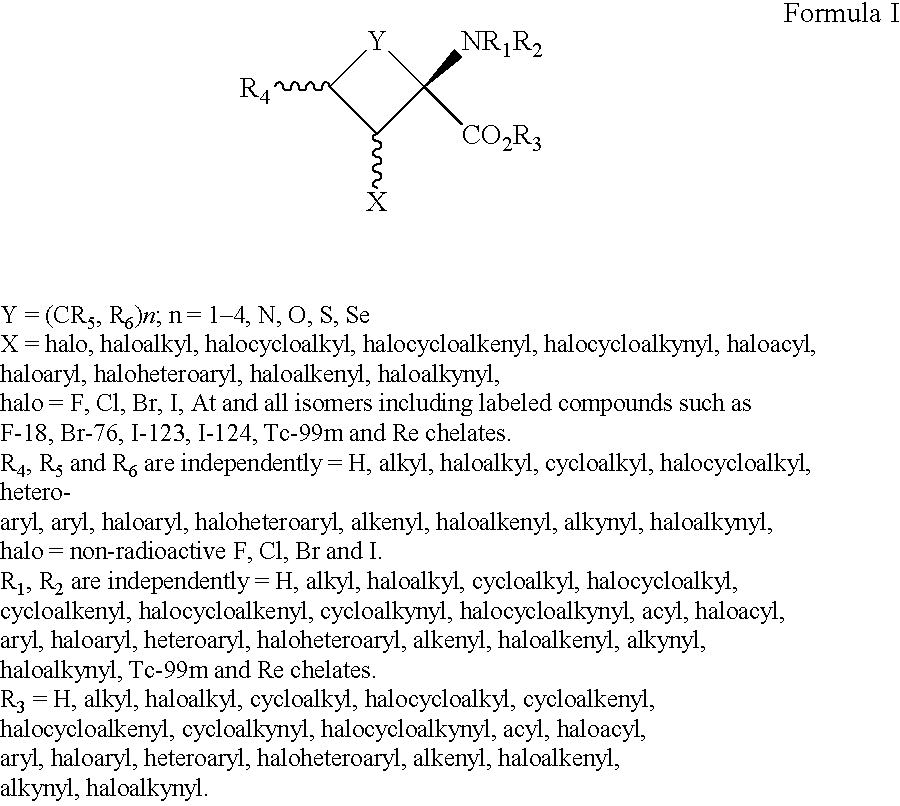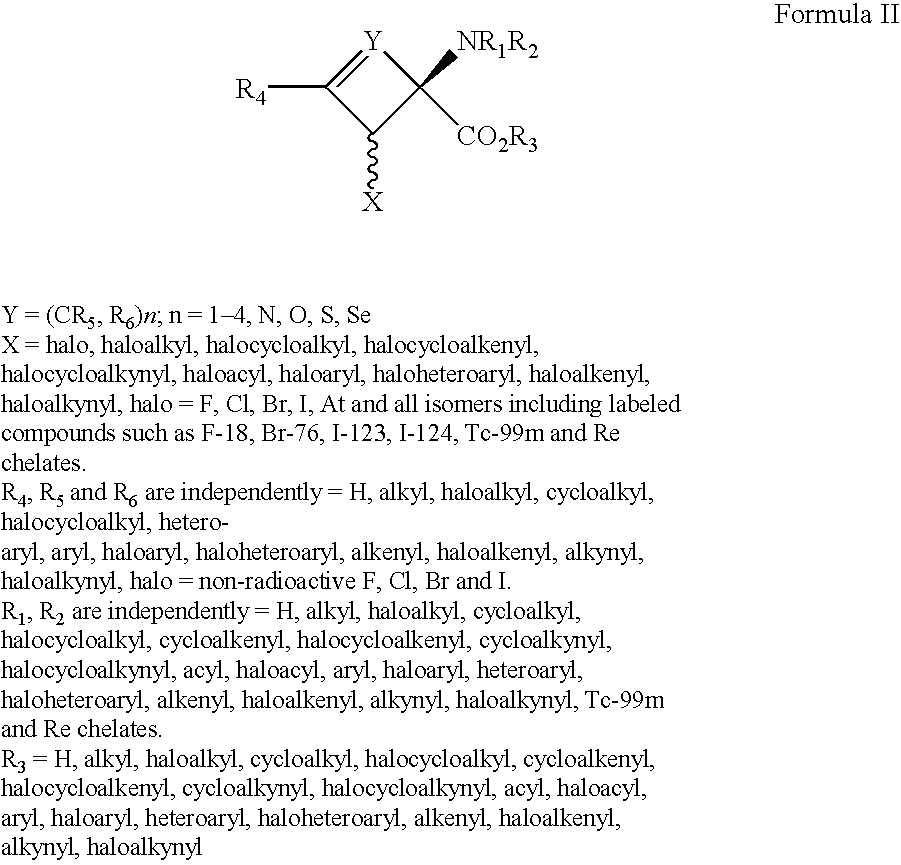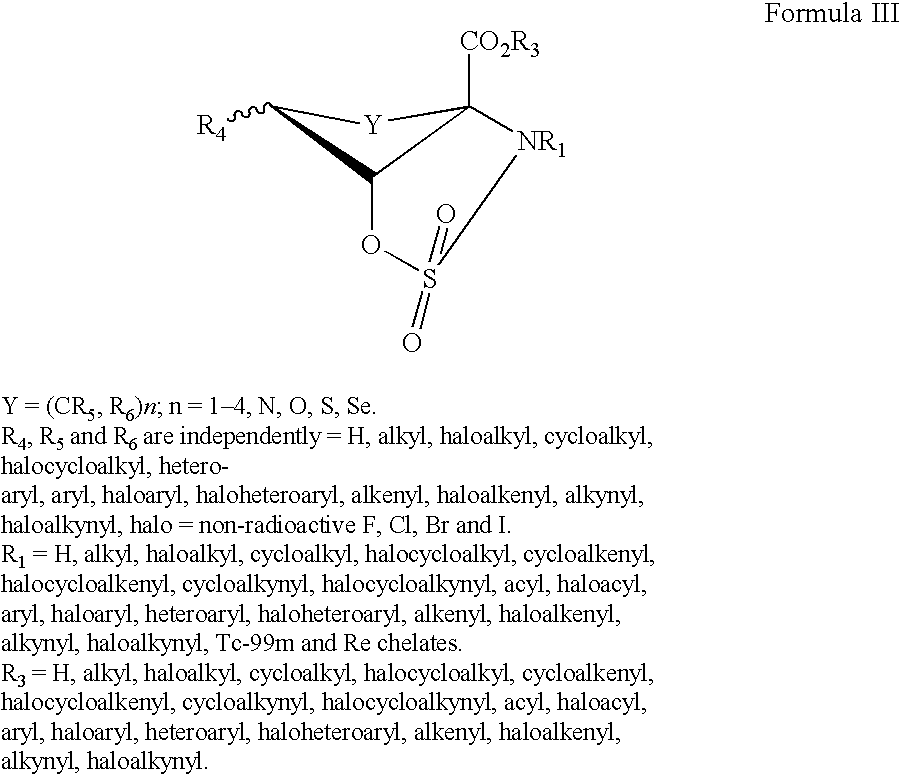Imaging Agents
a technology of amino acid analogs and imaging agents, applied in the field of new amino acid analogs, can solve the problems of insufficient detection of tumor recurrence, and insufficient detection of tumor recurrence, and achieve the effects of less moisture-sensitive, high yield, and more reactiv
- Summary
- Abstract
- Description
- Claims
- Application Information
AI Technical Summary
Benefits of technology
Problems solved by technology
Method used
Image
Examples
example 1
Synthesis of 2-FACBC
syn-5-(2-benzyloxycyclobutane)hydantoin (27) and anti-5-(2-benzyloxycyclobutane)hydantoin (28)
[0052] To a solution of 4 eq of ammonium carbonate (1.97 g, 20.5 mmoles) and 2 eq of ammonium chloride (0.55 g, 10.2 mmoles) in 50 mL of water was added 1 eq of the cyclobutanone 26 (0.9 g, 5.11 mmoles) in 50 mL of ethanol. After stirring at room temperature for 15 minutes, a 1.2 eq portion of potassium cyanide (0.4 g, 6.1 mmoles) was added, and the reaction mix was heated at 70° C. overnight. The solvent was removed under reduced pressure, and the crude cream colored solid was rinsed thoroughly with water to remove salts. The product (0.7 g, 51%) was obtained as a 9:1 mixture of syn:anti isomers.
syn-1-(N-(tert-butoxycarbonyl)amino)-2-benzyloxycyclobutane-1-carboxylic acid (30)
[0053] A suspension of compounds 27 and 28 (1.26 g, 5.1 mmoles) in 12 mL of 3N sodium hydroxide was heated at 110-115° C. overnight in a sealed stainless steel vessel. After cooling, the reacti...
example 2
Tumor Binding Specificity of Inventive Compounds
[0060] The inventive compounds have been evaluated in vitro for tumor binding specificity (i.e. uptake cells) using a variety of tumor cell lines available in the art, along with reference compounds such as Me-AIB and BCH. Detailed description of these assays can be found in Martarello et al. (2002) Journal of Medicinal Chemistry, 45:2250-2259 and McConathy et al. (2003) Nuclear Medicine and Biology, 30:477-490. These, so called “amino acid uptake studies” are typically carried out with radiolabeled compounds in at least five phenotypically different human tumor cell lines (e.g. A549 lung carcinoma, MB468 breast carcinoma, DU145 prostate carcinoma, SKOV3 ovarian carcinoma, and U87 glial blastoma). These tumor cell lines can be grown either in vitro or in vivo with severe combined immunodeficiency (SCID) mice as a host. The fore-mentioned tumor cell lines are available at the Winship Cancer Institute of Emory University.
[0061] For the...
PUM
| Property | Measurement | Unit |
|---|---|---|
| Capacitance | aaaaa | aaaaa |
| Fraction | aaaaa | aaaaa |
| Fraction | aaaaa | aaaaa |
Abstract
Description
Claims
Application Information
 Login to View More
Login to View More - R&D
- Intellectual Property
- Life Sciences
- Materials
- Tech Scout
- Unparalleled Data Quality
- Higher Quality Content
- 60% Fewer Hallucinations
Browse by: Latest US Patents, China's latest patents, Technical Efficacy Thesaurus, Application Domain, Technology Topic, Popular Technical Reports.
© 2025 PatSnap. All rights reserved.Legal|Privacy policy|Modern Slavery Act Transparency Statement|Sitemap|About US| Contact US: help@patsnap.com



